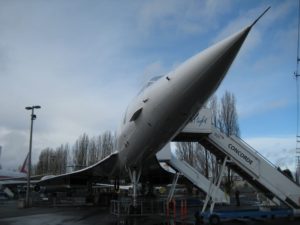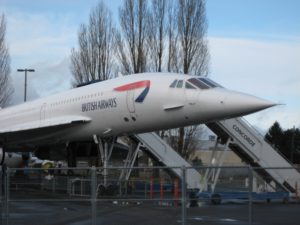I was talking with a friend last night about beautiful machines, mechanical things that are more than the collection of their parts. Today we got in the car and visited what is for me “exhibit A” in this argument – Concorde.
We drove to the Museum of Flight at Boeing Field; one of their star exhibits is Concorde G-BOAG. It sits there next to The City of Everett, the first ever 747, an aircraft that really did fulfil it’s promise and change the world in ways that even it’s designers could not fully imagine.
I used to work in London, a few miles from Heathrow and every morning just before 10 we would clearly hear the morning flight to JFK taxi and then take off. We were a little too far away to have the true window-rattling roar that 4 Rolls Royce Olympus are known for. Every morning meetings were disturbed as Speedbird 01 rolled down the runway and headed over the factory on take-off.
Concorde cost billions in public money to develop, the French and British governments sold the 14 production airplanes and all the spares to British Airways and Air France for 1 pound each.
The UK developed the engines and did a majority of the wings, France did most of the work on the airframe and the politicians argued over who was going to pay for what. As engineering tasks go many engineers as consider Concorde an achievement that is up there with putting men on the moon, in some aspects tougher.

At one point there were orders for 77 from 22 airlines, these included Iran Air, TWA, Air Canada, United, JAL and Pan-Am in addition to the nationally owned airlines of Britain and France. Oil prices and environmental concerns (mostly around the sonic boom) in the early 70’s meant most of these orders were canceled and in production stopped at 14 aircraft.
The story behind the genesis of Concorde is important and worth looking up if you are bored. The short version is that history shows trying to get the French and British to work together on something costing billions is near impossible. Concorde and the Channel Tunnel are probably the only successful examples, and the Channel Tunnel was dug with private money.
Concorde was only built because both sides were tied into it with a no-get-out clause that would have cost billions. It’s not often I say thank you to politician Tony Benn, but here I, and everyone else who appreciates aesthetics and form owe him as he ensured that it was going to happen.
British Airways found a niche market that allowed the to make a tidy profit. Rumour is they started the London-JFK service and had no idea what to charge. They asked some of the wealthy what they thought it was worth, and charged just that. It was possible to London mid morning and be in downtown Manhattan to join your banker friends for a second breakfast. Then be back in your own bed in London after a full days work
On the other side of the channel Air France never really worked out how to make money with the airplane, and reacted with a typical Gallic shrug when it was retired.
After the accident at Le Bourget it’s time was over, Aerospatiale said they were not going to supply parts anymore and it was over just like that. Concorde may be the only machine retired that did not have a better replacement, there is nothing comparable on the drawing boards of aero engineers anywhere.
Walking around the aircraft I’m reminded once again how beautiful it is. Men with slide rules and pencils designed this in the early 60’s. While some military aircraft could routinely break the sound barrier, they could do so for a few minutes before running out of fuel and needing their Avon engines changed. The idea of building an aircraft that would travel at Mach-2 from London to New York, then turn around and be back in London before the nine O’clock news started must have seemed optimistic at best.

3 Comments
I want to post quick hello and want to say appriciate for this good article about a gret machine
Very well written!
How much you have interesting things on the blog.